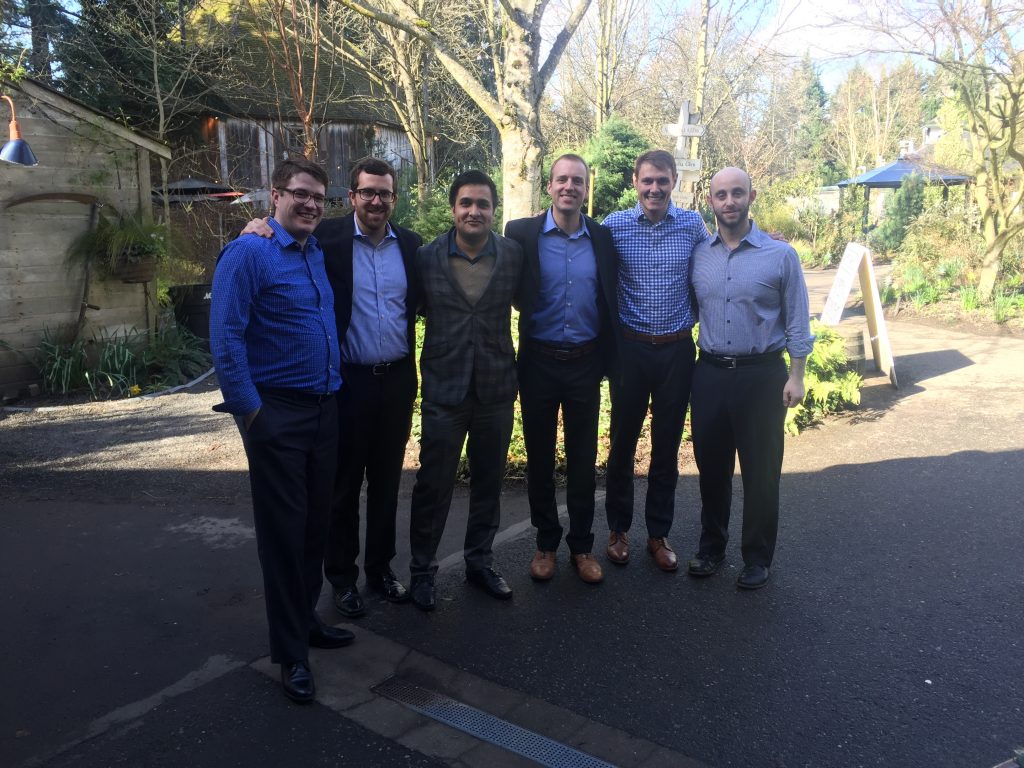Foster MBAs Gain Hands-On Experience at Intel

Foster MBAs after completing their final presentation with Intel
About the author: Jeff Olden is a second year MBA student concentrating in finance and strategy. Prior to the MBA program he worked as an engineering consultant specializing in energy analysis. Outside of work he loves skiing, running, hiking, golfing, and fly-fishing.
Like my fellow classmates, I came into the MBA program with a foundation of great work experience and excitement to take my career in a new direction. I was an engineer in my prior life; I had enjoyed it, but I pursued the MBA because I wanted to gain a broader understanding of how businesses make decisions. The classes I took in my first quarter started building the knowledge I needed for my new career, but the applied strategy project in my second quarter was when I received my first opportunity to gain real, hands-on experience.
At Foster, all full-time MBA students complete an applied strategy consulting project during their first year. The projects are a great opportunity to work on a real business case for one of the world-class organizations connected to Foster. There were projects with notable companies such as Boeing, Amazon, Microsoft, Google, Expedia, Providence Health, and Intel. Those interested in non-profits also had excellent opportunities to work with organizations promoting STEM education in minorities and helping empower lives through job-training. I was interested in pursuing a career in the technology sector, so I chose to work on a project for Intel.
The project I selected involved market research, market sizing, and segment recommendations for Intel’s High Performance Computing division – computers being used for computationally intensive and big-data applications. We were tasked with identifying industry trends for big-data use-cases and determining the product-market fit for an offering Intel was considering developing. The project was very broad and ambiguous; it was exciting to be working on a real business case.
The team we had access to at Intel was phenomenal. To give you an idea, our project sponsor and primary client was new to Intel, but she was a former McKinsey consultant with a PhD in Computer Engineering and over ten years of experience at the Director level within Microsoft. Her PhD dissertation had been on Neural Networks long before most of us had even heard of the term. Needless to say, we were working with some of the best minds in high performance computing.

Jeff Olden, Foster MBA Class of 2017
We dug into the project and soon learned that we had a very steep learning curve ahead of us and little time to complete our project. It was a true consulting project. We needed to come together quickly and leverage our combined strengths. One person on the team had a background in electrical engineering and was able to help us understand some of the basic terminology such as “software stack.” Another person had a background in finance and was more familiar with market sizing terms such as “Total Addressable Market (TAM)”, “Serviceable Available Market (SAM)”, and “Share of Market (SOM).” We also had team members with experience in health care administration, automotive, and engineering modeling; all of which were high-potential markets for the conceptualized product. The result was a team with many diverse experiences and a great combination of strengths. We just needed to figure out how bring it all together.
Fortunately, a few of us had also worked as consultants in the past and we received additional training from Foster Alums that were now consultants with Price Waterhouse Cooper (PwC). We took care to define an appropriate scope, started identifying key criteria for success, developed hypotheses, and dove into the available market reports. It sounds cliché, but adding structure to the project really helped us define our direction and enabled us to move forward quickly as a team.
We continued to charge through our market research, encountering some minor challenges along the way, but that was to be expected. We ultimately put together a presentation that provided the market size, product-market fit, and general trends for six potential markets. This was quite a feat to have accomplished in just a few short weeks having started with limited background knowledge.
Presenting our final results to a group of 20 Intel employees was fun and exciting. We had developed a formal power point presentation, but we were interrupted with a question within the first minute of our one-hour presentation and the presentation became highly conversational – we had previously been warned this was typical of Intel presentations. We spent the entire hour on our toes, constantly answering polite but challenging questions. I’d be lying if I didn’t say it was also just a little stressful. No pain, no gain – right?
In the end, the entire project was a great experience. We learned how to create structure to solve an ambiguous problem (a rite of passage for every MBA student) and gained experience on a real business problem. These experiences were an invaluable asset when it came time to begin interviewing for internships and later when it was time to begin my summer internship, which happened to be as a Sr. Financial Analyst Intern back at Intel Corporation.
